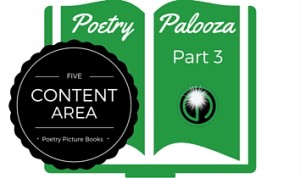
Welcome to part 3 of our Poetry Palooza! Throughout this month of April, we want to share with you some of our favorite poetry books (there are SO many good ones!) and some practical strategies for sharing poetry with your class that have been classroom tested and student approved!
Just joining us? Check out the previous posts in the series:
- Part 1: Five Science and Nature Poetry Picture Books
- Part 2: Five Classics, Fairy Tales, and Character-Building Poetry Picture Books
Pure mathematics is, in its way, the poetry of logical ideas.
~Albert Einstein
Poems? In content areas? It might be hard to believe, but it’s true! Poetry is a genre, so the content can be about anything! There are so many amazing poetry books that cover content in social studies, science, and even math! The books in this post are a great way to double-dip in the classroom and save yourself time as you fuse poetry with YOUR content area!
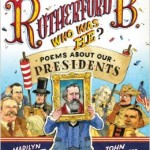 Rutherford B. Who Was He? Poems about our Presidents by Marilyn Singer:
Rutherford B. Who Was He? Poems about our Presidents by Marilyn Singer:
Before I even begin, I must provide a disclaimer. I NEVER share my political view outside of my own home and definitely not around my students, ever! It is not my job impart my feelings to students, but rather to provide them a learning environment and opportunity to form their own opinions. So, this book has a poem on each page dedicated to each president from Washington to Obama. The poems are clever and short. They do not provide a complete biography of the president, because it is such a short poem. Therefore, Singer had to choose a characteristic or moment from the presidency to highlight. That being said, many reviewers have been concerned with the favoring of liberal presidents while condemning the conservative presidents. My opinion is this: poetry is supposed to evoke feeling and emotion, the reader must decide what to do with the information. I would love to present this to my students and have a discussion as to who Singer favors as far as presidents go. Students will need to back up her feelings with text evidence from the poem. Talk about deep reading a poem! From here, students can read a biography of Singer and see if there is any more evidence to support their conclusions about her. Also, this is a great time for the students to research the presidents themselves. Could they write a poem that sheds that president in a new light? We could then show the presidents from different perspectives.
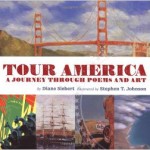 Tour America: A Journey Through Poems and Art by Diane Siebert:
Tour America: A Journey Through Poems and Art by Diane Siebert:
Poetry, art, and geography, oh my! I don’t even know how I got my hands on this book, but it had been in my classroom for ages and had be desperately underutilized! Twenty-six states are represented on their own separate page in this book. For each state, one specific destination is mentioned, a poem is written about the place, and a beautiful piece of art captures the mood. The artwork by Stephen T. Johnson is varied mixed-media throughout the book. In addition to the poem and artwork, each page has a text box of information about the site with a map of where it is located. Map out these sites, choose new sites to research and write your own poems, pull out facts, and analyze poems for word choice and description, but don’t forget to take the students there! Use Google Maps to take the students on virtual field trips. Below, I mapped Lucy the Elephant in Margate, New Jersey from the book. Below are some snapshots from my field trip!
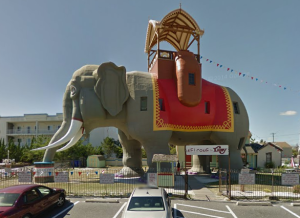
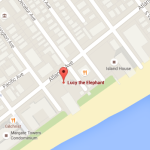
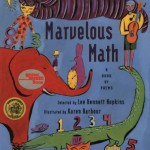 Marvelous Math by Lee Bennett Hopkins:
Marvelous Math by Lee Bennett Hopkins:
I love this book for the primary classroom. Hopkins pulls poems from fun poets such as Kuskin and Dotlich to help teachers integrate poetry and math. The poems help students see that math is all around them. Do they want to calculate speed of a car, build a house, and tell time? All these things require knowledge of math. Explaining concepts in whimsical poems help students learn and relate to the math concepts.
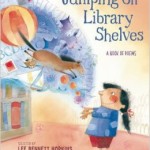 Jumping off Library Shelves by Lee Bennett Hopkins:
Jumping off Library Shelves by Lee Bennett Hopkins:
Once again, Hopkins has collected poems from popular poets such as Yolen and Grimes, as well as a few written by herself, all about the library. Those of you who know us, know we LOVE our librarians! So what better way than to honor them in our series then to highlight a book about their kingdom. This book covers everything reading. The excitement of getting a library card, how one feels about the library, getting pulled in to a book, even searching the internet is covered in poem included in this collection. These poems, while not deep, contain strong vocabulary. Discuss word choice with the students, but also print the poems to place around the library or in the reading corner. Both reading teachers and librarians can use these poems to excite students about reading.
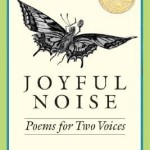 Joyful Noise: Poems for Two Voices by Paul Fleischman:
Joyful Noise: Poems for Two Voices by Paul Fleischman:
This clever book is for language and science teachers. This entire book of poems is about insects, but is written for two voices. Each “voice” has their own column, sometimes they read alone, sometimes together, sometimes they listen. This is great for speaking and listening standards as well as teaching fluency. The style is engaging, the poems flow well, and the content helps teach science. I have used this book with second graders and fifth graders. Both groups of students loved reciting poetry and working with each other. There are two other books that are similar: I am Phoenix: Poems for Two Voices about birds and Big Talk: Poems for four voices.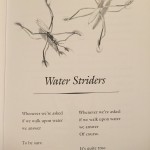
What poetry picture book would you add to the list?






Thank you for compiling the literature. What a fantastic resource!